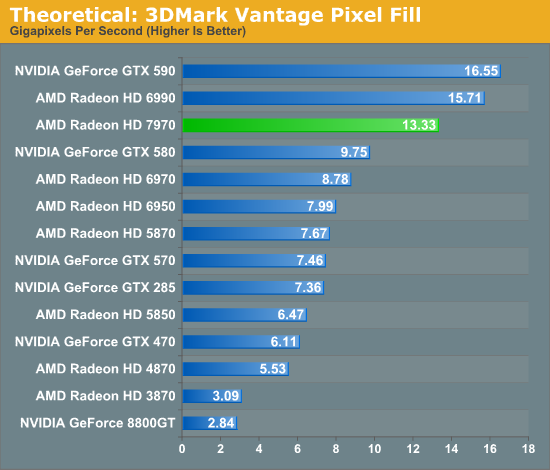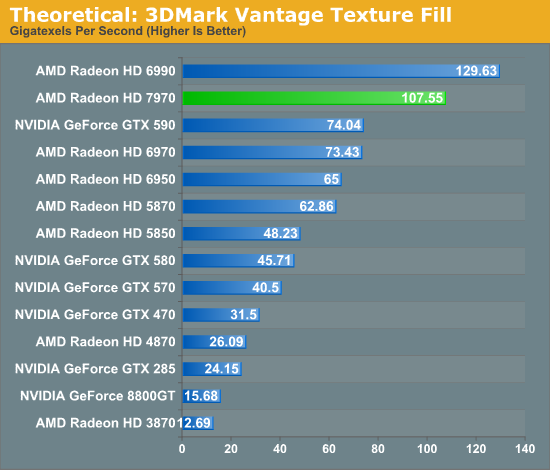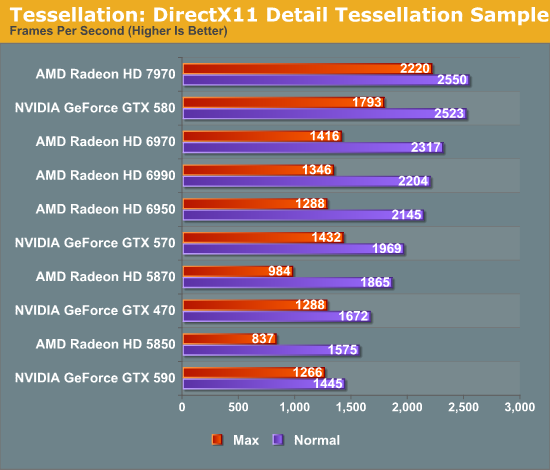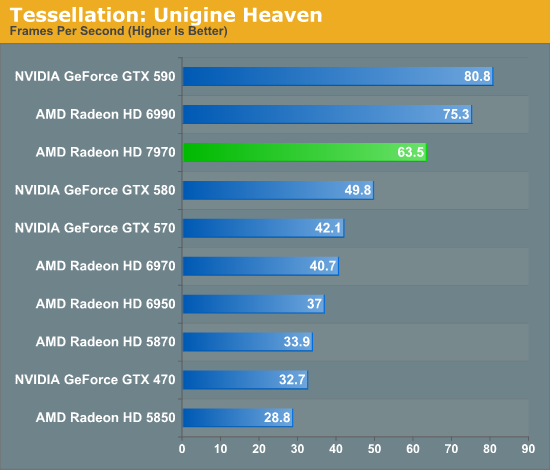AMD Radeon HD 7970 Review: 28nm And Graphics Core Next, Together As One
by Ryan Smith on December 22, 2011 12:00 AM EST- Posted in
- GPUs
- AMD
- Radeon
- ATI
- Radeon HD 7000
Theoreticals & Tessellation
From a rendering perspective one of the most interesting things AMD did with Tahiti was what they didn’t do: they didn’t add more ROPs, they didn’t add more geometry engines. And yet based on our game performance they’ve clearly improved on their performance in those situations by making more efficient use of the hardware they do have.
So we wanted to take a quick look at synthetic performance to see what these tools had to say about AMD’s changes. We’ve included the numbers for every other GPU in our lineup as a reference point, but we would strongly suggest against reading into them too much. AMD versus AMD is sometimes relevant to real world performance; AMD versus NVIDIA rarely is.

We’ll start with 3DMark Vantage and its color fill test. This is basically a ROP test that attempts to have a GPU’s ROPs blend as many pixels as it can. Theoretically AMD can do 32 color operations per clock on Tahiti, which at 925MHz for 7970 means the theoretical limit is 29.6Gpix/sec; not that any architecture is ever that efficient. In practice 7970 hits 13.33Gpix/sec, which is still well short of the theoretical maximum, but pay close attention to 7970’s performance relative to 6970. Even with the same number of ROPs and a similar theoretical performance limit (29.6 vs 28.16), 7970 is pushing 51% more pixels than 6970 is.
In designing Tahiti AMD said that they didn’t need more ROPs they just needed more efficient ROPs, and it looks like they’ve delivered on this. It’s not clear whether this is the limit for efficiency or if AMD can squeeze more out of their ROPs in future designs, but this definitely helps to prove that there’s more to graphics rendering than a large number of functional units.

Our other 3DMark synthetic benchmark is the 3DMark Vantage Texture Blend test, which measures how quickly a GPU can blend multiple FP16 textures. This is more synthetic than most tests because FP16 textures aren’t widely used, but it’s a consistent benchmark.
The theoretical performance improvement from 6970 to 7970 is 40% - 33% more texture units operating at a 5% higher clockspeed. In practice the 7970 exceeds that improvement by increasing texture performance by 46%, meaning the 7970 has benefitted from more than the increase in texture units. Most likely the new cache architecture has further improved the efficiency of the texture units, although the 3DMark texture set is not particularly large.
Moving on, we also wanted to take a look at tessellation. AMD did not increase the theoretical geometry performance of Tahiti as compared to Cayman – both top out at 2 triangles per clock – but AMD has put a lot of effort into improving the efficiency of Tahiti’s geometry units as we’ve seen reflected in our game benchmarks.

Our first tessellation benchmark is the traditional Detail Tessellation sample program from the DirectX SDK. Here we’re looking at tessellation performance as a product of the framerate, testing at tessellation factors 7 (normal) and 15 (max). Traditionally this is a test that has been rather balanced at normal tessellation levels, while NVIDIA cards with their superior geometry throughput have been the top performers at maximum tessellation levels. So it’s all the more interesting when we’ve seen the tables turned; the 7970 is merely competitive with the GTX 580 at normal tessellation levels, but now it’s ahead of the GTX 580 by 24%. More significantly however the 7970 is ahead of the 6970 by 57%.

Our second tessellation benchmark is Unigine Heaven, a benchmark that straddles the line between a synthetic benchmark and a real-world benchmark, as the engine is licensed but no notable DX11 games have been produced using it yet. In any case the Heaven benchmark is notable for its heavy use of tessellation, which means it’s largely a proxy test for tessellation performance.
As with the Detail Tessellation sample program, Heaven shows significant gains for the 7970 versus the 6970, with the 7970 leading by 56%. Meanwhile it leads the GTX 580 by 27%, which is actually slightly better than what we saw under the more “pure” Detail Tessellation sample. Between these two benchmarks it’s clear that AMD’s tessellation efficiency improvements are quite real, and that with Tahiti AMD can deliver much better tessellation performance than Cayman even at virtually the same theoretical triangle throughput rate.
Of course one has to wonder what NVIDIA will have in store for Kepler next year. Their current Fermi design seems to scale well with additional geometry units, but if Tahiti is anything to go by, there’s a great deal to be gained just by focusing on efficiency. NVIDIA has prided themselves on their geometry performance since before GF100 even shipped, so it will be interesting if they have anything in store to hold on to that distinction.










292 Comments
View All Comments
Scali - Saturday, December 24, 2011 - link
I have never heard Jen-Hsun call the mock-up a working board.They DID however have working boards on which they demonstrated the tech-demos.
Stop trying to make something out of nothing.
Scali - Saturday, December 24, 2011 - link
Actually, since Crysis 2 does not 'tessellate the crap' out of things (unless your definition of that is: "Doesn't run on underperforming tessellation hardware"), the 7970 is actually the fastest card in Crysis 2.Did you even bother to read some other reviews? Many of them tested Crysis 2, you know. Tomshardware for example.
If you try to make smart fanboy remarks, at least make sure they're smart first.
Scali - Saturday, December 24, 2011 - link
But I know... being a fanboy must be really hard these days..One moment you have to spread nonsense about how Crysis 2's tessellation is totally over-the-top...
The next moment, AMD comes out with a card that has enough of a boost in performance that it comes out on top in Crysis 2 again... So you have to get all up to date with the latest nonsense again.
Now you know what the AMD PR department feels like... they went from "Tessellation good" to "Tessellation bad" as well, and have to move back again now...
That is, they would, if they weren't all fired by the new management.
formulav8 - Tuesday, February 21, 2012 - link
Your worse than anything he said. Grow upCeriseCogburn - Sunday, March 11, 2012 - link
He's exactly correct. I quite understand for amd fanboys that's forbidden, one must tow the stupid crybaby line and never deviate to the truth.crazzyeddie - Sunday, December 25, 2011 - link
Page 4:" Traditionally the ROPs, L2 cache, and memory controllers have all been tightly integrated as ROP operations are extremely bandwidth intensive, making this a very design for AMD to use. "
Scali - Monday, December 26, 2011 - link
Ofcourse it isn't. More polygons is better. Pixar subdivides everything on screen to sub-pixel level.That's where games are headed as well, that's progress.
Only fanboys like you cry about it.... even after AMD starts winning the benchmarks (which would prove that Crysis is not doing THAT much tessellation, both nVidia and new AMD hardware can deal with it adequately).
Wierdo - Monday, January 2, 2012 - link
http://techreport.com/articles.x/21404"Crytek's decision to deploy gratuitous amounts of tessellation in places where it doesn't make sense is frustrating, because they're essentially wasting GPU power—and they're doing so in a high-profile game that we'd hoped would be a killer showcase for the benefits of DirectX 11
...
But the strange inefficiencies create problems. Why are largely flat surfaces, such as that Jersey barrier, subdivided into so many thousands of polygons, with no apparent visual benefit? Why does tessellated water roil constantly beneath the dry streets of the city, invisible to all?
...
One potential answer is developer laziness or lack of time
...
so they can understand why Crysis 2 may not be the most reliable indicator of comparative GPU performance"
I'll take the word of professional reviewers.
CeriseCogburn - Sunday, March 11, 2012 - link
Give them a month or two to adjust their amd epic fail whining blame shift.When it occurs to them that amd is actually delivering some dx11 performance for the 1st time, they'll shift to something else they whine about and blame on nvidia.
The big green MAN is always keeping them down.
Scali - Monday, December 26, 2011 - link
Wrong, they showed plenty of demos at the introduction. Else the introduction would just be Jen-Hsun holding up the mock card, and nothing else... which was clearly not the case.They demo'ed Endless City, among other things. Which could not have run on anything other than real Fermi chips.
And yea, I'm really going to go to SemiAccurate to get reliable information!